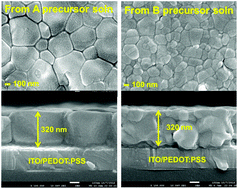Effect of precursor components on the photovoltaic performance of MA1−xFAxPbI3−yBry films prepared via a one-step method†
Abstract
Organic–inorganic lead halide perovskites represent a group of materials with diverse structures and promising optical/optoelectronic properties. The performance of perovskite based solar cells relies tremendously on the structure/properties of the absorber. The physicochemical properties of the perovskite active layer depend on the substrate, preparation methods, environments and the starting materials. In this study, we investigated the effects of starting materials in the precursor solution on the physicochemical properties of the resulting one-step spin coated MA0.8FA0.2PbI3−yBry film and the photovoltaic performance of the corresponding inverted (p–i–n) perovskite solar cells. Two precursor solutions containing exactly the same atom stoichiometry were prepared from two different groups of starting materials (Group A: CH3NH3I, CH(NH2)2I, CH3NH3Br, and PbI2; Group B: CH3NH3I, CH(NH2)2I, PbI2 and PbBr2). The MA0.8FA0.2PbI3−yBry films (A1 and A2) prepared from the A precursor solution had better photovoltaic performances compared to those (B1 and B2) obtained from the B precursor solution for the same y values. The stoichiometry of the film to achieve the best photovoltaic performance (the corresponding cell has the highest efficiency) is not the same for the A-group (prepared from the A precursor solution) and B-group films (prepared from the B precursor solution). The photovoltaic performance of the perovskite film is directly correlated to the crystallinity, morphology and defect sites of the film as evidenced by GIXRD, scanning electron microscopy (SEM) and transient photoluminescence (TRPL) data. The morphology of the mixed-halide perovskite films depends on the homogeneity of the halide stoichiometries. The A-group films with more possible halide stoichiometries have better crystallinity and continuity compared to those of the B-group films, probably due to the difference in the crystallization rates for the two group perovskite films. Therefore, for preparing mixed-halide perovskites with the same average halide stoichiometry, starting materials that can produce perovskite films with more halide stoichiometries are a better choice.

- This article is part of the themed collection: In honour of Mercouri G. Kanatzidis for his contributions to Inorganic Chemistry for over 30 years


 Please wait while we load your content...
Please wait while we load your content...